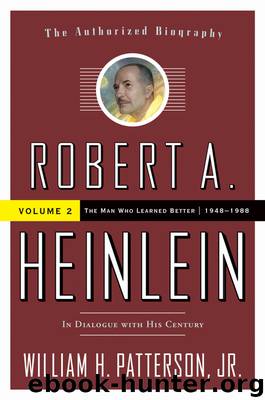Robert A. Heinlein, In Dialogue with His Century, Volume 2 by William H. Patterson Jr

Author:William H. Patterson, Jr.
Language: eng
Format: epub
ISBN: 9781429987967
Publisher: Tom Doherty Associates
25
ON TO OTHER THINGS
Editors and publishers had always sent Heinlein manuscripts hoping to get a comment to use on the book jacket. Most of the time he was able to talk himself out of doing it, although sometimes a little treasure fell into his lap that way: He always appreciated Ted Sturgeon sending him the galleys for Edgar Pangborn’s Davy (1964), for instance. For friends and acquaintances he often put a lot of work into technical critiques. One of their friends in Colorado, Dottie White, had written a novel in 1960 about an interracial marriage—from personal experience. Her Negro husband, George White, was a major at one of the local Air Force establishments at Colorado Springs. Heinlein had given her what advice and help he could, and tried to help her find an agent for the book. In 1973, Arthur Clarke’s publishers wanted a puff for the paperback issue of Rendezvous with Rama, and he was happy to oblige with that one.
In June 1973, Jerry Pournelle sent him a gigantic manuscript for a science-fiction novel he had written in collaboration with Larry Niven, Motelight, and Heinlein girded up his mental loins for another job of analysis and technical critique. As he read, though, he found himself turning pages, getting involved with the characters and the story. But it had a major fault as a book that urgently needed to be addressed.
He spent three days going through the manuscript almost line by line, and finally, on June 20, sat down at the typewriter to frame his critique. His first note to the authors was:
“1. This is a very important novel, possibly the best contact-with-aliens story ever written.… (best aliens I’ve ever encountered, truly alien but believable and one could empathize with them, every ecological niche filled, total ecology convincing, etc.—grand[.])”1
With Pournelle, he knew he could be straightforward and even blunt—and there simply was no “delicate” way of saying some of the things he thought needed to be said—
We are in a highly competitive market, battling each year against not only thousands of other new novels but also TV and a myriad other things … in the late XXth century one simply cannot use up 30,000 words before getting down to business with the main story line.…
How to correct the major fault? I don’t know. It’s your story. But cutting the bejasus out of those [first] 100 pp would help. It is all featherdusting, not story, and you need to determine just what supporting data must be saved to keep the plot intact—then see how much of it can be tucked away into corners after page 100, and what is left that must be on stage before page 100—and what is left be told in such a way as to grab the reader and pull him along, not lose him.2
Heinlein’s experience with this kind of hard-love advice was not encouraging: “People seldom take advice—and this advice you did not ask me to give. I shan’t be offended if you don’t take it; I hope that you will not be offended that I proffer it.
Download
This site does not store any files on its server. We only index and link to content provided by other sites. Please contact the content providers to delete copyright contents if any and email us, we'll remove relevant links or contents immediately.
4 3 2 1: A Novel by Paul Auster(11033)
The handmaid's tale by Margaret Atwood(6836)
Giovanni's Room by James Baldwin(5870)
Big Magic: Creative Living Beyond Fear by Elizabeth Gilbert(4718)
Asking the Right Questions: A Guide to Critical Thinking by M. Neil Browne & Stuart M. Keeley(4566)
On Writing A Memoir of the Craft by Stephen King(4205)
Ego Is the Enemy by Ryan Holiday(3982)
Ken Follett - World without end by Ken Follett(3968)
The Body: A Guide for Occupants by Bill Bryson(3789)
Bluets by Maggie Nelson(3705)
Adulting by Kelly Williams Brown(3663)
Guilty Pleasures by Laurell K Hamilton(3578)
Eat That Frog! by Brian Tracy(3505)
White Noise - A Novel by Don DeLillo(3430)
The Poetry of Pablo Neruda by Pablo Neruda(3358)
Alive: The Story of the Andes Survivors by Piers Paul Read(3302)
The Bookshop by Penelope Fitzgerald(3220)
The Book of Joy by Dalai Lama(3212)
Fingerprints of the Gods by Graham Hancock(3206)
